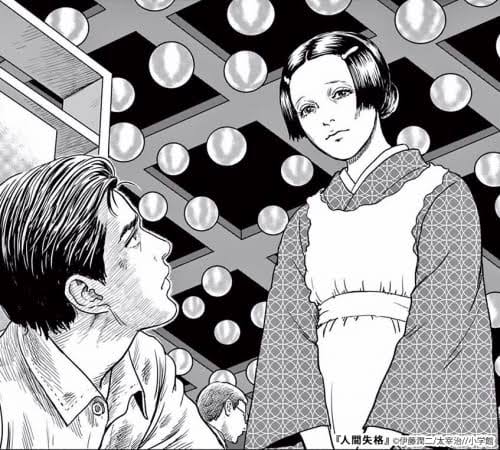
こんにちは。amazonで注文して読みました。原作となる太宰治の「人間失格」は1948年に書かれました。僕はこの辺りの、特に明治から大正、昭和初期くらいにかけての文学に疎く、今回改めて調べ直しました。例えば夏目漱石は明治から大正に活躍した作家で、芥川龍之介は大正から昭和初期に、そして太宰治は昭和に活躍しています。有名な話ですが太宰治は芥川龍之介を敬愛していたらしく、芥川龍之介のポーズを真似た写真を何枚も撮っていたりします。どうでも良いことですが1948年という時代は、意外と最近だなと感じます。その年は小津安二郎が「風の中の雌鳥」(1948)を撮っていたりして、戦後間もない混乱した時代だったのだと推察します。黒沢清は「ニンゲン合格」(1999)などのネーミングや、「DOORⅢ」(1996)の藤原のキャラクターデザインなど太宰治が好きなのかもしれません。僕は「人間失格」(1948)を前に一度読んだと思いますが、全然内容を覚えていませんでした。伊藤潤二は改めて「富江」(1987)を読んでみると、それこそ初期の1974年くらいから1976年くらいにかけての大友克洋に画風がそっくりです。その頃の大友克洋は後年の「童夢」(1980)や「AKIRA」(1983)などの緻密な描き込みではなく、少女漫画のようなスタイリッシュな省略を用いていたので、かなり余白が多い大胆な構図の大コマがあったりします。また台詞を吹き出しに入れずに詩のような浮遊感のあるかなり前衛的な試みをしていたりもします。話が逸れましたが、伊藤潤二の「人間失格」(2017)の話に戻ります。原作がそうなのでしょうがかなり濡れ場が多い漫画です。また伊藤潤二の最近の作品を読んでいなかったので正確には分かりませんが、恐らくデジタルで処理したであろうと思われる箇所がいくつかあったりして、それも新鮮でした。伊藤潤二の個人的に凄いと思っているところに、基本的に一人で描いているところです。仕上げなどを人に頼むことはあるそうですが、基本は一人というのはとてつもないことだと思います。原作に無いエピソードとして作中の大庭葉蔵が太宰治本人に出会う、というものがあります。作中でも触れられていますが、芥川龍之介はドッペルゲンガーを見た、という逸話があったりするので、芥川龍之介のファンである太宰治なら原作にあっても不思議ではないエピソードだったと思います。
hello. I ordered it from Amazon and read it. The original, Osamu Dazai's "No Longer Human" was written in 1948. I am unfamiliar with the literature around here, especially from the Meiji, Taisho, and early Showa eras, so I re-examined this time.For example, Soseki Natsume was active in the Meiji and Taisho periods, Ryunosuke Akutagawa was active in the Taisho and early Showa periods, and Osamu Dazai was active in the Showa period. It is a famous story, but Osamu Dazai seems to have admired Ryunosuke Akutagawa, and he took many photographs imitating Ryunosuke Akutagawa's pose. It doesn't matter, but I feel that the era of 1948 is surprisingly recent.Yasujirō Ozu was filming Hen in the Wind (1948) that year, so I guess it was just after the war and it was a chaotic time. Kiyoshi Kurosawa may like Osamu Dazai for naming such as "Ningen pass" (1999) and Fujiwara's character design for "DOOR III" (1996). I think I read "No Longer Human" (1948) once before, but I didn't remember the contents at all.When I reread Junji Ito's "Tomie" (1987), the style of painting is very similar to that of Katsuhiro Otomo in his early period from 1974 to 1976. At that time, Katsuhiro Otomo used stylish abbreviations like those of shoujo manga, rather than the meticulous drawings of his later works such as "Dome" (1980) and "AKIRA" (1983). There may be a large frame of the Also, I try to be quite avant-garde, like poetry, without putting dialogue into speech bubbles. I digressed from the topic, but I will return to Junji Ito's "No Longer Human" (2017). The original is probably so, but it is a manga with a lot of wet spots. Also, I haven't read Junji Ito's recent works, so I don't know exactly, but there are some parts that I think were probably digitally processed, which was also fresh. composition.What I personally think is amazing about Junji Ito is basically drawing alone. I heard that he sometimes asks others to finish his work, but I think that basically it is a tremendous thing to do alone. As an episode not in the original work, there is an episode in which Yozo Oba meets Osamu Dazai himself.Although it is touched on in the work, there is an anecdote that Ryunosuke Akutagawa saw a doppelganger, so I think that Osamu Dazai, who is a fan of Ryunosuke Akutagawa, would not be surprised if it was an episode in the original.